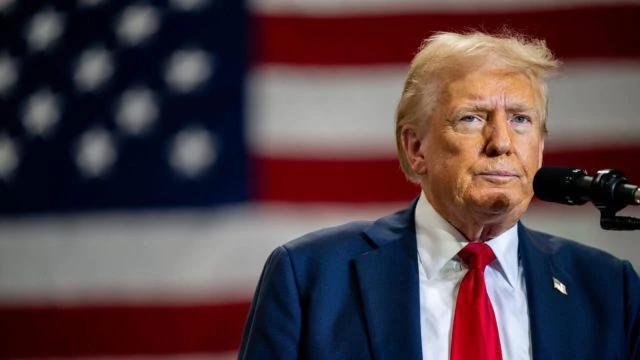
How countries are responding to Trump’s game of chicken over tariffs: Why Asian markets are betting on Japan’s move over China’s playbook
There are three differing templates emerging of how countries are responding to US President Donald Trump’s retaliatory tariffs. On one end is the Chinese playbook of “resolute opposition” and tit-for-tat retaliation.
China’s Commerce Ministry has thrown down the gauntlet, vowing to take countermeasures to safeguard its own rights and interests against Trump’s threat that he would impose an additional 50 per cent duties on imports by the US from China, if Beijing did not withdraw the 34 per cent tariff imposed on American products last week to match the levy slapped by Washington earlier.
Japan opts for negotiated settlement
Japan seems to be on the other end of the spectrum, getting ready to dispatch a team to negotiate with Washington — one of the early movers in this game. US President Trump said Monday that he had spoken with Japanese Prime Minister Shigeru Ishiba and confirmed that Japan is dispatching a team to negotiate on trade with US Treasury Secretary Scott Bessent and Trade Representative Jamieson Greer.
Japan’s stock markets seem to have taken cue, with the benchmark Nikkei 225 surging over 6 per cent and the Topix up nearly 7 per cent in early trade. Other Asian markets tracked gains in Japanese equities. After witnessing heavy selling pressure for the last three trading sessions, the Sensex and Nifty too recovered by over 1 per cent in the opening trade on Tuesday.
The optimism in the Asian markets is pegged on the belief that the Japanese could crack the negotiations and get Washington DC to pipe down on the tariffs imposed on Tokyo, in turn allowing Trump to claim victory. That could set the template for others to follow. There are those that are keen to submit, with Bangladesh, the world’s second-largest ready-made garment exporter after China, now offering to buy various US farm products, including cotton, duty-free in an effort to avoid reciprocal US tariffs. Cambodia and Vietnam too are reported to be looking at the conciliatory option. Whether European and American markets will take the cue from early gains in Asian equities is something that holds the key to whether market players in the West genuinely buy into Trump’s mood to negotiate.
EU considering both options
The response from the European Union slots somewhere in between the reactions from Japan and China. The trade ministers of the 27-nation bloc had gathered in Luxembourg to discuss their response to Washington’s new trade regime. Given that the trans-Atlantic trade relationship is the biggest in the world, worth about 1.5 trillion Euros, there is considerable worry across European capitals. EU officials, however, came out to say that they would rather negotiate than fight the US on tariffs, but in parallel, they are preparing a potential list for retaliation and other measures for retaliation. A negotiated solution, though, is the preferred option, as voiced by some of the attendees at the Luxembourg meeting, and unusually seconded by Trump’s ally in Washington, Tesla CEO Elon Musk.
India has largely maintained a studied silence for the better part of the last 48 hours, other than a bare-bone basic statement that it was examining the American tariff order. Responses since then have been piece-meal, with individual ministries playing down the impact on their respective constituents. Privately, though, officials have indicated that New Delhi has opted for negotiations, rather than a “retaliatory approach”, a sharply different strategy from the approach taken during the first Trump administration when New Delhi responded to American steel and aluminium tariffs with countermeasures of its own.
China’s resolute opposition
In the case of China, the American tariffs have pushed the Chinese markets deep in the red, with Hong Kong’s Hang Seng plunging the most in almost three decades. The concern in that part of the world is that Trump has slapped tariffs multiple times, with the threat of new ones looming on the horizon. The first set of 10 per cent tariffs on Chinese goods were imposed in February, plus another 10 per cent in March, plus 34 per cent announced last week, and now the threat of an additional 50 per cent, which altogether effectively doubles the import cost of all Chinese goods to the US. That would effectively create an economic blockade between the world’s two biggest economies where there is just going to be no trade. Trump has given Beijing time till Wednesday afternoon to withdraw its 34 per cent tariffs.
Between the US and China, it does seem that Beijing could have greater leverage and the staying power in managing an escalatory tariff spiral, at least in the short term. Unlike Trump, Chinese President Xi Jinping is not faced with elections anytime soon, there is very little internal opposition to his management of the economy at this point in time, and the country is already in the middle of a stimulus package roll out that includes a combination of fiscal and monetary measures. China has far more staying power when it comes to continuing its fiscal stimulus package well into the future. Beijing also has the option of stepping up its internal project of deepening the country’s domestic consumption market, something that will take in some of its export surpluses if the tariff war were to be long drawn out.
The United States is at a disadvantage in all of this. There is little firepower on the fiscal side, except the prospect of an extension of corporate tax concessions that Trump had promulgated in his last term. Worryingly, there is also an impending showdown that the Trump administration is likely to have with the US Federal Reserve on the issue of cutting interest rates, which Fed Chair Jerome Powell has indicated is unlikely to happen anytime soon.
It might be tougher for the US to play the long game with China on this escalatory spiral.





